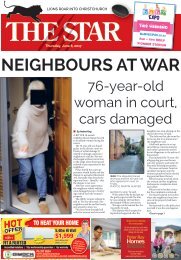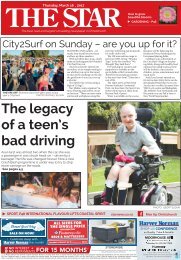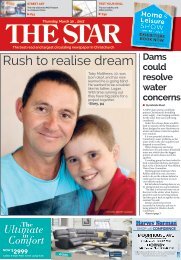Review of the Tsunami Evacuation 2017
Create successful ePaper yourself
Turn your PDF publications into a flip-book with our unique Google optimized e-Paper software.
national warning cancellation message. It appears <strong>the</strong> Deputy Commissioner in Wellington had access<br />
to information from MCDEM earlier than <strong>the</strong> information being issued by MCDEM to CDEM Groups.<br />
Prior to 14 November, CDEM staff had a process underway to update and communicate <strong>the</strong> Previous<br />
<strong>Evacuation</strong> Plan illustrating <strong>the</strong> evacuation zones. The review process was not complete and <strong>the</strong><br />
updated maps were not yet signed <strong>of</strong>f. Since 14 November, an updated interactive tsunami<br />
evacuation map has been posted on Council’s website 3 . The current map provides for two different<br />
evacuation zones depending on <strong>the</strong> tsunami threat. <strong>Evacuation</strong> zone “red” relates to a tsunami threat<br />
for beach, foreshore and marine areas. <strong>Evacuation</strong> zone “orange” relates to a tsunami threat which<br />
impacts land areas. <strong>Evacuation</strong> zone “orange” covers <strong>the</strong> risks associated with local, regional or distant<br />
source tsunamis. In o<strong>the</strong>r words, <strong>the</strong> map is based on a worst case scenario in order to provide<br />
residents with one map to refer to. The Council’s interactive map enables users to enter <strong>the</strong>ir address<br />
to determine whe<strong>the</strong>r that property is inside <strong>the</strong> evacuation zone. There are also pdf printable<br />
versions <strong>of</strong> <strong>the</strong> specific area maps available on <strong>the</strong> same webpage. They are high level maps which do<br />
not provide specific street names so are more difficult to apply to specific properties.<br />
Recommendations<br />
Residents require information and education on <strong>the</strong> differences between local, regional and distant<br />
source tsunamis and how to respond in each case. The reliance on activation <strong>of</strong> sirens should be<br />
addressed. Self-directed evacuation <strong>of</strong> residents in <strong>the</strong> evacuation zones must be encouraged to avoid<br />
delay. A good communication strategy is required to engage with residents and co-create material<br />
which covers <strong>the</strong> types <strong>of</strong> tsunami risk, <strong>the</strong> role sirens play, o<strong>the</strong>r methods <strong>of</strong> communicating an<br />
evacuation, evacuation procedures and routes to be taken by residents, etc. for each community.<br />
All o<strong>the</strong>r relevant agencies (including Fire Brigade, CDEM Group, CDEM, Canterbury District Health<br />
Board, and Ministry <strong>of</strong> Education) with input from local communities, should be coordinated to assist<br />
Christchurch Police with <strong>the</strong> Police <strong>Evacuation</strong> Plan review. This will ensure that <strong>the</strong> Police <strong>Evacuation</strong><br />
Plan dovetails in with any material and messaging issued by o<strong>the</strong>r agencies and seek endorsement<br />
from affected residents. The review should also consider how <strong>the</strong> security <strong>of</strong> residents’ homes could<br />
be managed.<br />
In addition to <strong>the</strong> Police <strong>Evacuation</strong> Plan, an evacuation plan specific to each community should be cocreated<br />
with <strong>the</strong> o<strong>the</strong>r agencies and residents (Community <strong>Evacuation</strong> Plan). It should cover <strong>the</strong><br />
different responses required depending on a local, regional and distant source tsunami. The<br />
Community <strong>Evacuation</strong> Plan should include methods <strong>of</strong> evacuation (running, cycling, etc.) and specific<br />
exit routes that evacuees can follow to reduce traffic congestion, where possible. Additionally, <strong>the</strong><br />
Community <strong>Evacuation</strong> Plan should cater for <strong>the</strong> evacuation <strong>of</strong> vulnerable residents and visitors who<br />
are not able to self-evacuate. Consideration should be given to whe<strong>the</strong>r <strong>the</strong> Community <strong>Evacuation</strong><br />
Plan should cater for night vs day scenarios. Additionally, <strong>the</strong> evacuation <strong>of</strong> pets should be<br />
incorporated into each Community <strong>Evacuation</strong> Plan. A specific welfare centre (which is as close as<br />
possible) outside <strong>the</strong> evacuation zone should be identified in <strong>the</strong> Community <strong>Evacuation</strong> Plan to<br />
provide a destination for those residents who need somewhere to stay and information on what<br />
resources will be provided at that centre.<br />
Once agreed between <strong>the</strong> various agencies and residents, <strong>the</strong> Community <strong>Evacuation</strong> Plan should be<br />
made publicly available and disseminated in conjunction with o<strong>the</strong>r tsunami information to residents<br />
within that community in all forms to make it as accessible as possible.<br />
Consideration should be given to exploring <strong>the</strong> idea <strong>of</strong> engaging contractors (and possibly volunteers)<br />
to assist Police with traffic management coordination in an evacuation. In <strong>the</strong> same manner that<br />
3 https://www.ccc.govt.nz/services/civil-defence/what-to-do-in-an-emergency/tsunami/evacuating<br />
16















